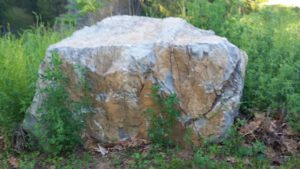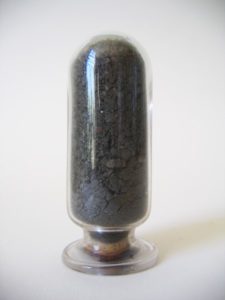Andebit et beaqui corendit, ut quostes esciendion re dit ad et prae parion es quia quas alibus sam, omnim faciden ducipidiat arum autem nobis enis es voat

8. Driving from Hammondville to the White Church
The Business of Iron
Listen to the Site 8 Iron Story Narration

The Sax-Floyd Bed (sometimes spelled Saxe) was one of the first Crown Point iron beds discovered. John Saxe, the first to come to America, was born in Germany in 1732. During an apprenticeship with a Pennsylvania miller, he learned the ways of mills and waterwheels. He eventually set up grist mills in northern Vermont. One of his sons, Jacob Sax (the e got dropped), became the family “ironman.” He learned to mine iron at a young age, pulling bog iron from the swamps and sluggish rivers near Highgate, Vermont. By 1819, at the age of 36, he became a partner of an iron furnace in Plattsburgh. Just a year later, he was also running a blast furnace along the Salmon River in Clinton County. But he was looking for a better source of iron. Around 1823, he bought an ore bed that had been discovered by Samuel Renne in Crown Point. Renne had been working the ore from this bed at his nearby forge on Putnam Creek, near the present-day fish hatchery. Once Sax took over, workers picked, shoveled, and blasted their way into a vein of iron extending into a hillside of exposed rock. The iron ore here was red and was sometimes used to make paints. Although John Renne’s forge was less than a mile away, Sax and his men had to cart the ore 4.5 miles to the Crown Point ferry wharf and then transport it by sloop down Lake Champlain to their own landing at the mouth of the Salmon River in Clinton County. This was a laborious process at best. It was reported that the Sax ore, when mixed with other ores “worked to good advantage.” Later, more scientific examinations showed the mineral content included a great deal of jasper and red pigment. Jacob Sax continued to work his Crown Point ore bed and his Plattsburgh blast furnace during the 1820s. Then disaster struck.
In July 1830, a huge flood swept his furnace, his dam, his coal house, and his mills into a jumbled mess far out into Lake Champlain. Only his stone house, south of the furnace, remained. Sax never rebuilt and eventually moved to Chesterfield where he operated a forge (Highlands Forge). At some point, Sax lost control of or sold his ore bed in Crown Point. In later years, the ore bed became known as the Sax and Floyd Bed. It seems to have been abandoned around 1860. Richer ores in abundance were available nearby from the Penfield and Hammondville mines.
Nevertheless, the mining techniques allowed small operators like Sax to work iron. The bloomery process could be easily fired up and shut down, whereas blast furnaces needed constant operating.

According to one historian, by 1880, Essex County was the second-ranking iron-producer in the country. But this dominance had its costs, eventually contributing to the decline in the iron industry in the area. The demand for bloom iron shrank dramatically across the country as self-made steel tycoon Andrew Carnegie and his followers rapidly and consistently developed new technologies to use lower quality ore to make higher-quality steel. Carnegie also developed fully integrated plants, where iron mining, coal mining, railroad transport, and steel production all took place in one area.
In contrast, Adirondack iron companies had to bring in coal once charcoal was depleted, they had no on-site production facilities, and they had to transport their iron a considerable distance to be transformed into products. Yet for most of the lifetime of these companies, they felt they had little need to spur innovation: In the beginning, the nearby mountains produced what seemed like an endless supply of wood for charcoal and the ore itself was so pure there was little incentive by local iron companies to change the way they were mining or refining the iron ore—or to keep up with trends in steel making. That lack of change would eventually be the downfall of the region’s iron industry. Once company owners recognized that they needed to modernize or become more efficient, it was largely too late.
Travel Tools
From Penfield Museum turn left off Creek Rd. onto Hamilton Rd (third left). Turn right on Treadway Road. The Saxe-Floyd Ore Bed “crevice” is visible near the “Stop Ahead” sign on the left side of Treadway Road.
Please note that the ore bed is on private property and there is no safe pull-off to stop. The brick home next to the ore bed was the home of the Floyd family, who later bought the iron ore bed. You can inquire with staff at the Penfield Museum, which occasionally leads tours to some of the iron-related sites, such as this one.
First Person Account:
Slag–the remains of the iron-smelting process–can be quite beautiful and can still be found in woods of what was once Hammondville: “Winslow Watson visited this [Hammondville] furnace in 1852 and has left the following account of what he saw there: ‘In approaching the furnace I observed the road for some distance was formed by a very beautiful material, exhibiting a surface soft and lustrous and glowing in every shade and tint. this substance was the concretion of slag or cinders of the furnace. When gushing from the stack in fusion, it will form and draw out, by a wire trust into the boiling mass, an attenuated glass thread the entire length of the furnace, a distance of 60 feet. The glass presents a most delicate and- diversified coloring although combined in the eruption from the furnace with extraneous properties. Thus beautiful in its crude and adulterated condition may not this substance, purified and refined by science be rendered subservient to the arts?’ At the present day, in the forest growth that has since overrun the site of this historic enterprise, pieces of this glassy slag are to be found, their varying tones of blue and green as fresh as when Watson saw them nearly ninety years ago. The roads for some distance away, now winding through shady woods, have been repaired with this rare material which so excited his admiration and imagination at that time.” -From E.E. Barker, The Story of Crown Point Iron, 1942.


